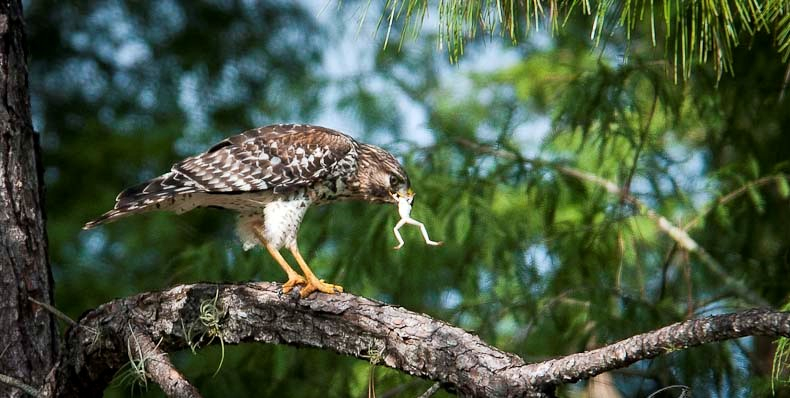Hawks
Hawks are carnivorous birds since they are predatory birds of prey. Carnivores do not eat any vegetation; they exclusively consume animal products. Sharp talons and beaks of birds of prey, commonly referred to as "raptors" aid in the capture of prey. Hawks need to hunt in order to survive. A hawk's diet consists of a wide variety of animals. Small animals including rabbits, squirrels, gophers, prairie dogs, mice, and chipmunks are the ones that hawks most frequently prey on. Insects like dragonflies, crickets, grasshoppers, and moth larvae as well as fish, reptiles, and amphibians including lizards, turtles, frogs, crabs, crawfish, and koi are further examples of what hawks eat.
Frogs have a reputation for being a favorite diet among hawks that live close to ponds, rivers, or other bodies of water. The most well-known frog-eating birds, however, are Red-shouldered hawks and American kestrels.
These hawks that feed on amphibians enter observation mode when they are hungry to keep an eye out for prey. In order to determine which of the frogs are susceptible, they start the monitoring process by flying in the open sky at a great height or simply from tree branches. With their keen eyesight, they can easily track amphibians from a great distance. Once the prey has been discovered, the hawk has two ways to catch it. The first is to soar straight down after flying right over the frog. Hunting on the ground is the alternate choice. After descending a short distance from the frog, the hawk soars quickly and straight up at a 90-degree angle. Wild hawks adopt one of the two strategies, so there's time to capture the frog before it even tries to jump correctly. Additionally, because the hawk is going quicker, turning is more challenging. The hawk consequently always appears from the frog's rear. Frogs, on the other hand, can only hear other frogs because of their exceedingly poor hearing. The hawk promptly uses its toes to grasp the frog once it is close enough for it to do so. The advantage of having three toes facing forward and one pointing backward is that hawks may capture any prey with ease because of their unique arrangement. As soon as they get a grip on the target, they twist and soar above. The hawk joyfully eats the frog after bringing it to a comfortable area.











